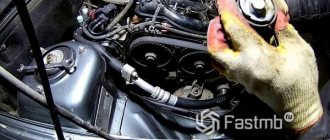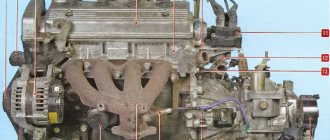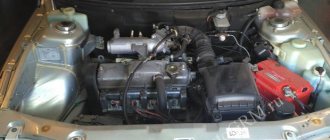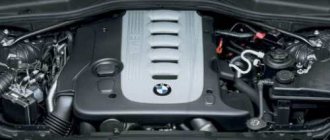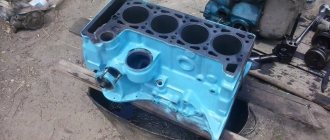In pursuit of growing demands from customers and European officials, ten years ago manufacturers decided to greatly limit engine displacement, further improving their performance and flexibility. In theory, this should also reduce fuel consumption and, above all, emissions of harmful substances. One such example from the VAG concern is the 1.2 TSI petrol engine (TFSI in the Audi catalog), which is also installed in Seat and Skoda. Did he inherit good genes after 1.4 and 1.6 MPI?
Successor to 1.4 and 1.6 MPI
The German four-cylinder gasoline engine became the direct successor to the well-worn, but very durable and respected by users, 1.4 and 1.6 MPI engines with a power of 80-105 hp. The subcompact design appeared on the market in 2009. To realize their plans, Volkswagen engineers used 8-valve printed head technology, an electronically controlled variable blade geometry turbocharger, as well as direct fuel injection and a single camshaft. Another characteristic difference of the 1.2 TSI engine is the gas distribution system, which is carried out using a chain that cannot be replaced under the manufacturer’s warranty. Depending on the version, the engine generates 86, 90, 105 or 110 hp. (since 2014), which, in combination with the relatively light body of the Volkswagen Polo or Skoda Fabia, translates into sufficient performance also outside the city. The 1.2 TSI under the hood of a heavy Octavia or Golf doesn't work so well. Often there just isn't enough power, especially with a bunch of passengers on board. Despite this, when driving quietly on the highway it consumes about 5-6 liters of fuel. Attempts at dynamic driving over subsequent kilometers even end with a double increase in fuel consumption of 10-12 l/100 km.
What are the disadvantages
Like any thing, the TSI engine also has some disadvantages. It should not be forgotten that most modern turbocharged VW engines are very picky about the quality of fuel and oil. The TSI engine is no exception; for normal operation it requires only high-quality fuel and.
In addition, the TSI engine requires the owner to strictly adhere to the rules for operating turbo engines specified in the vehicle documentation.
In addition, the TSI engine may cause some discomfort in winter. The reason is that the TSI engine of the family has low heat transfer and practically does not heat up when idling in the cold season. In general, the optimal temperature regime of a given engine is achieved only while driving after a certain period of time.
But there is another side of the coin, already positive - such an engine is not prone to overheating even in extreme heat in a long traffic jam. However, this feature can cause discomfort when operating a car with a TSI engine over short distances: an unheated engine means an unheated interior, since a traditional “stove” that uses engine antifreeze in its work will be ineffective.
But VW engineers took into account all these nuances by creating a dual-circuit cooling system with two thermostats: one circuit cools the hotter cylinder head, the second cools the rest of the power unit block.
To increase the service life of the TSI engine, the turbine is cooled by its own system, including an electrically driven water pump, which continues to circulate coolant for another 15 minutes after the engine is stopped.
Every abbreviation in the auto industry means something. So, the concepts FSI and TFSI also matter. Only here is the difference between almost identical abbreviations. Let's look at what is included in the names and what is the difference between them.
We recommend versions after 2012
The 1.2 TSI was produced in this form in 2012. Unfortunately, before modernization, the engine has many operational problems. At the moment, experts do not report any serious failures for units produced after 2012. The manufacturer has removed all problematic design errors. The timing chain was replaced with a much cheaper belt - replacement interval is 210 thousand kilometers. A 16-valve head and two camshafts appeared. The number of changes was so great that after 2012 the engine received a completely new designation - EA211. As before, its strengths were flexibility and low fuel consumption in quiet operation. We can't help but pay attention to the rapid achievement of operating temperature.
Camshaft supports
Another problem lurked in the camshaft supports. A check valve was used in the front camshaft support number 06H103144J. It is needed in order to ensure the fastest supply of oil during a cold start of the engine and the rapid exit of the phase regulator to operating mode. And this simple part of a steel ball, a spring and a plastic case with a mesh filter failed. The remaining plastic tore the filter, and debris began to “walk” through the system, getting into the camshaft lubrication line and into the phase shifter. The latter usually could not survive this. Of course, the chain could slip or even break, damaging the valves and cylinder head.
This defect could be encountered even with low mileage; sometimes 40-60 thousand kilometers of city trips were enough. A solution was found: new meshes appeared on sale, and the valve body in the new supports became metal.
Note on engines of the first years of production
Unfortunately, experts do not recommend buying cars with 1.2 TSI engines before upgrading (EA111). These examples will cause many expensive problems for the owner. The first few tens of thousands of kilometers of operation of the 1.2 TSI does not create any particular difficulties; in addition, it will delight you with satisfactory dynamics and low fuel consumption. But the idyll does not last long. Defects in design and materials make themselves felt very quickly. As with other units in the TSI family from Volkswagen, this engine also struggles with a major problem, which is the timing chain. It is only for life in theory. Already after 50-70 thousand kilometers, it can stretch so much that it can jump several teeth and even break the engine. Both situations result in pistons colliding with valves, which means expensive engine repairs. Replacing a used chain along with the necessary attachments will cost hundreds of dollars at an authorized service center. You also need to be prepared for a bad head gasket. Despite the mileage, it may require urgent replacement.
Let's sum it up
Volkswagen group cars are one of the best solutions in their classes. This is a laconic technique, nice design and modern developments, which are combined in quite interesting and unusual operation options. Skoda cars today can claim to inherit all the pleasant and positive functions of the German brand. If earlier in Skoda all technologies appeared one generation later than in VW, today this trend is no longer relevant. The company develops new products and immediately introduces them into all modern models of the concern. And the 1.8 TSI engine in different cars of the company today has the same nature. This is a fairly high-quality and reliable unit with good power and excellent endurance.
Cars with such an engine show quite high operational reliability and can please you with their technical capabilities and simply remarkable operating qualities. Transport has both its advantages and disadvantages, and the engine in this case is one of the main representatives for forming the buyer’s opinion. So you should pay special attention to the unit, take into account all its advantages and disadvantages when purchasing. Negative reviews are often due to the fact that the potential owner simply did not take into account all the features of the unit before purchasing. We recommend that you study more information about the engine and then choose a modification of the car. What do you think about the new generation of the 1.8 TSI engine?
Increased oil consumption
Unfortunately, a significant part of the gasoline engines of recent years created by VAG 1.2 TSI engineers also consume a large amount of oil. With such a disease, we will not save in any case. Experts say that this type of engine is just that. The user can only regularly monitor the oil level and top up immediately. Remember that a lack of fluid will very quickly affect the condition of the turbocharger, etc. For safety, it is worth shortening the oil change interval. Before modernization, there could also be problems with the turbocharger. Relatively often, the electronic control of variable blade geometry “stutters,” which is manifested by a drop in power and an increase in flow rate. Violation of operating rules significantly reduces the service life of this element - its repair will also be very expensive.
The 1.2 TSI wasn't known for its durability until 2012. There were situations during this period when the manufacturer exchanged the engine for a new one under warranty with a mileage of 20-30 thousand kilometers. Before buying a car, you should carefully check the service history and be aware of design flaws. It is better to use the versions after modernization. They are much more durable and cheaper to operate. EA211, we can recommend with a pure heart.
What can you complain about?
The advantages of the TSI engine are somewhat overshadowed by some disadvantages. Firstly, it requires exclusively high-quality consumables, and primarily gasoline, which, as you know, is not cheap. It is recommended not to neglect the required regular maintenance. services.
Secondly, winter problems: the engine is not able to warm up at idle. You have to reach the operating temperature on the go, while moving. People who use the car primarily on the home-to-work route will have to get used to some coolness in the cabin with good disadvantages outside: the heater will simply drive cold air from the engine. In this case, there will be no problems with starting the car; you can start driving almost immediately after turning on the ignition.
However, the unit will probably not cause any other troubles or difficulties. We can say that power and reliability are what the TSI engine from Volkswagen is.
Many of you, dear readers (who are interested in German cars), sometimes when choosing, for example, Volkswagen or its subsidiary Skoda, come across this question. What is a TSI engine? After all, these brands have ordinary units and some with an incomprehensible abbreviation - TSI. I also asked myself the same question and found this information...
Everyone has heard about the ordinary ones (Volkswagen and Skoda), as well as (AUDI), but TSI engines remain a mystery for the Russian consumer. What kind of motor is this? There are many sayings, especially in a drunken company, there is always a kind of expert (who knows everything and has heard everything). I myself once sinfully thought that this was a diesel option. I thought so because it produces more power with a smaller volume than, for example, a simple turbocharged unit. But no, this is not a diesel engine.
The brightest representative of the class is the 1.4-liter version from Volkswagen. It has received so many awards and critical acclaim, it’s simply an ideal among turbines!
1.2 TSI engine - serious faults
Unfortunately, it quickly became clear that the loaded and complex small engine has a short resource and does not travel long distances. Circuit timing problems, turbocharger damage and control electronics failures are the most common (but not all) engine failures from the start of production.
Due to obvious shortcomings, at the end of 2012 the manufacturer introduced a modified version of the TSI 1.2 engine, in which it eliminated most of the problems. The timing is driven by a belt rather than a chain, the head has 16 valves rather than 8, and they are controlled by two rollers. The changes were so great that after modification the engine received a new series EA211 (formerly EA111).
What to do with a car from the “problem” group?
The original pistons for VAG were produced by Mahle. But it is not the only manufacturer of the piston group for these engines. Kolbenschmidt makes a good replacement for AE pistons - the KS40251600 series, also with oil drain slots.
In the latest revisions of this piston, the oil scraper ring is set, pay attention to this. There is also a version for a 23 mm piston pin KS 40 761 600, although it is less common. If the pistons are old, then you also need Mahle 02814N0 or Mahle 03319N0 rings.
Thus, if your engine has a 21 mm piston pin, then the best way to solve the problem is to install KS40251600 or AE pistons, if you can find them at a reasonable price. Usually it starts from 11 thousand rubles, but options are possible.
If the engine has piston pins with a diameter of 23 mm, then you will either have to limit yourself to BS pistons, or look for the very rare KS 40 761 600.
If the piston burns out due to jammed compression rings, then you will have to sharpen the block, fortunately it is cast iron, and the piston group has repair dimensions. True, pistons 40761610 and 40761620 - the first and second repair sizes, respectively - are significantly more expensive than the base ones. So lining a cast iron block is a very common way out of the situation. You can even get by with used pistons with modifications, since the pistons themselves are strong. And there are a lot of “orphan” pistons in nature: they are replaced en masse.
1.2 TSI engine - typical faults
The breakdowns concern the version with EA111, which entered the market in 2009 and, as it soon became clear, had many problems. Later versions with EA211 (since 2012) do not yet show any significant shortcomings. What kind of damage should be expected for engines before upgrading? First of all, the timing chain stretches quickly - if the user does not react in time, the chain can come off and cause serious engine damage.
Damage to the head gasket and increased oil consumption are quite real. Quite often a problem arises with the exhaust gas cleaning system and turbocharging (the valve sticks). There are also control problems that cause the engine to run rough and, in extreme cases, even burn out the piston due to combustion temperatures being too high. For this reason, the engines were replaced after a short mileage under warranty.
Injectors
The direct injection injectors of the 1.4 TSI engine serve very well, but carbon deposits from low-quality fuel and questionable additives in it lead to the formation of carbon deposits near the nozzle. Improper fuel atomization leads to engine shaking at idle and under load, and misfires also appear, which can be caused by carbon deposits on the intake valves. In some cases, injectors can be washed with a special product, but in general it is safer to change them.
You can select and buy injectors for the Volkswagen 1.4 TSI engine, injectors for the Seat 1.4 TSI engine, Skoda 1.4 TSI injectors or Audi 1.4 TSI injectors in our catalog of contract spare parts.
1.2 TSI engine - timing chain failure
Symptoms : metallic noise from the timing drive (especially after a cold start).
Repair - the problem is well known to the VW Group service. An overstretched chain and tensioner create problems. Moreover, there have been cases of chain skipping and serious engine damage. Therefore, if symptoms appear that indicate a problem, you should contact a repair shop as soon as possible to diagnose and correct the problem. If the warranty period has expired, the cost of replacing the chain, guides and tensioner is about $500.
1.2 TSI engine - maintenance
| every 30 thousand km | every 60 thousand km | every 90 thousand km | every 120 thousand km | every 210 thousand km | |
| Change of oil * | + | — | — | — | — |
| replacing the air filter | — | + | — | — | — |
| replacing the fuel filter | — | + | — | — | — |
| replacing spark plugs** | — | — | + | — | — |
| valve clearance check | — | — | — | — | — |
| checking the condition of the attachment belt | + | — | — | — | — |
| Replacing the attachment belt*** | — | — | — | — | — |
| timing drive replacement**** | — | — | — | — | + |
* or every year (in engines from the beginning of production - every 2 years); ** iridium spark plugs; *** the manufacturer does not provide for periodic replacement - the auxiliary drive belt must be replaced by a mechanic; **** applies only to the upgraded EA211 engine (timing chain used on EA111 units)
1.2 TSI engine - interval and maintenance recommendations
Drive synchronization - in 1.2 TSI engines after modernization (EA211) the timing system of the belt drive - the interval for its replacement is 210 thousand. km. In our conditions, it should be reduced by 50 thousand km. On the other hand, engines before the modification (EA111) used a timing chain, which, in theory, should work without problems until major engine repairs - unfortunately, in practice it is often replaced up to 100,000 km.
Oil change - in the case of EA111 engines, the manufacturer provided for an oil change every 30,000 km or every 2 years - now the time interval has been reduced to one year. Whereas mechanics advise changing the oil every 8 - 15 thousand. km or once a year, especially for engines with chain synchronization.
Engine 1.2 TSI - consumables
Engine oil - For extended oil change intervals (every 30,000 km), the manufacturer recommends using only 5W-30 synthetic oil in accordance with VW specification 504.00. System volume: 3.6-3.9 l.
Synchronization - The 1.2 TSI EA111 engine uses chain synchronization, while the EA211 version uses a belt. The valve clearance is reset hydraulically.
Cooling system - the manufacturer does not recommend periodic replacement. The operation of the cooling system is limited to checking the fluid level and checking for frost resistance. The volume of the system depends on the model and ranges from 5.6 to 8.3 liters.
How it works?
The design genius when creating the TSI engine was manifested in the fact that it is equipped with double supercharging.
The engine has both a turbocharger and a mechanical supercharger. Which one comes into play depends on the speed at which the engine is running. The process can be divided into 4 stages. Idle - up to 1000 rpm. There is no boost at all. The supercharger-mechanics is turned off, the damper that regulates and controls the process is open. Due to the fact that the gas exhaust is small (and its energy, accordingly, too), the turbocharger does not come into play.
The revolutions exceed 1000, but have not yet reached 2400. The damper closes and a mechanical supercharger starts working, creating a boost pressure of 0.17 MPa. The turbo is involved in this only to create minor additional air compression.
Between 2400 and 3500 rpm
The turbocharger operates primarily. The pressure rises to 0.25 MPa. The mechanical supercharger is mostly dormant, joining the turbo only when more power is needed. For example, during sudden acceleration.
After accelerating the engine above 3500 rpm, the mechanics are completely turned off, and the supercharger does not participate in the operation of the engine. The control valve remains in the open position. In this case, the boost pressure drops slightly to , and in this operating mode is 0.18 MPa at a rotation speed of 5500 rpm.
We also note the enhanced cooling system in 2 circuits: one is responsible for the temperature in the cylinder block, the other maintains it within normal limits on the head. To prevent the latter from overheating, an additional electrically driven water pump is equipped, which circulates water through a separate circuit for another 15 minutes after the engine is turned off.
Thanks to all these tricks, there is a noticeable fuel economy, a reduction in harmful emissions and a significant increase in engine life.
The Germans also took care of sound insulation: the motor is packed in an additional casing made of sound-absorbing foam, and all gas flows, both incoming and outgoing, are passed through noise suppressors.
Engine 1.2 TSI - technical data
| 1.2 TSI* | 1.2TSI | 1.2TSI | 1.2 TSI* | 1.2TSI | 1.2TSI | |
| Year of release | 2009-14 | since 2012. | starting from 2014. | since 2009. | since 2012. | starting from 2014. |
| Engine - type, number of valves | t.benz. R4/8 | t.benz. R4/16 | t.benz. R4/16 | t.benz. R4/8 | t.benz. R4/16 | t.benz. R4/16 |
| Working volume | 1197 | 1197 | 1197 | 1197 | 1197 | 1197 |
| Compression ratio | 10,1:1 | 10,1:1 | 10,5:1 | 10,0:1 | 10,5:1 | 10,5:1 |
| Timing type | OHC | DOHC | DOHC | OHC | DOHC | DOHC |
| Power max. (kW/HP/rpm) | 63/86/4800 | 63/86/4800 | 66/90/4400 | 77/105/5000 | 77/105/5000 | 81/110/5000 |
| Max. torque (Nm/rpm) | 160/1500 | 160/1500 | 160/1400 | 175/1550 | 175/1400 | 175/1500 |
| Injection type | straight | straight | straight | straight | straight | straight |
*engines with timing chain drive
1.2 TSI engine - our opinion
If you choose the 1.2 TSI engine, then the version after modification (EA211). This is a heavily rebuilt engine that has been stripped of many of the important issues that plagued its predecessor, the EA111. When the car is properly maintained, the 1.2 TSI engine really successfully combines low fuel consumption with decent dynamics, especially in B-segment cars.
Previous
Driving at low speeds can lead to malfunctions
Definition
TSI engines
- These are gasoline units with double turbocharging (which also contain mechanical compressors) and a system of direct “layered” fuel injection. The structure is much more complex than a conventional turbocharged engine, but it is worth noting that reliability, power and efficiency are at a very high level. It is practically free of flaws.
If you look at the abbreviation, there are several definitions. One from 2000 (that's when it was developed) - Twincharger Stratified Injection
- translation (double supercharging layer-by-layer injection), but later, around 2008, another translation appears
Turbo Stratified Injection
- (turbocharging layer-by-layer injection), that is, the “double” value is removed, it was during these years that the production of power units with a single supercharger began

